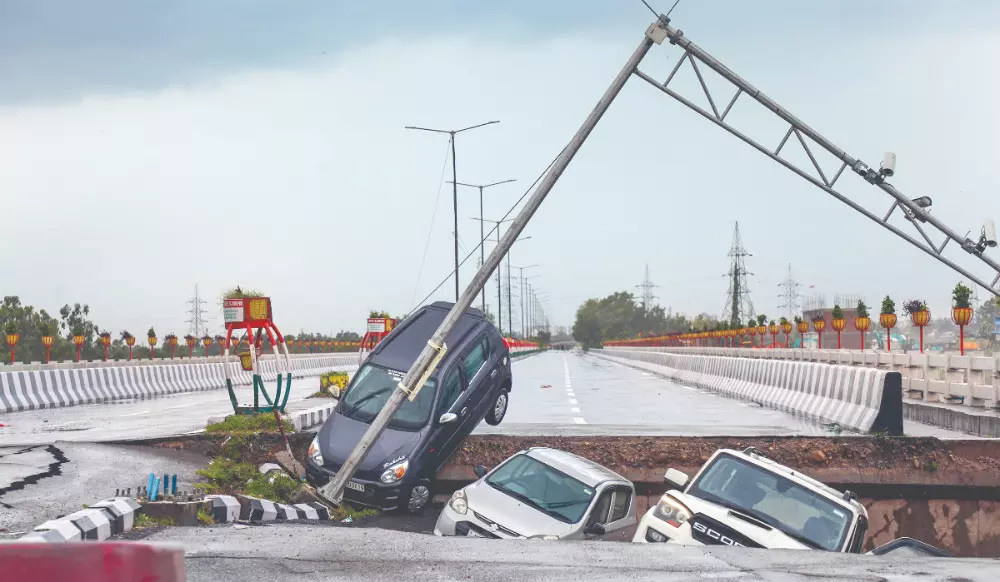
New Delhi, Aug. 26 -- Northern India faced a day of severe weather on Tuesday as relentless rains battered the Himalayan region, triggering landslides, flash floods, and widespread infrastructural damage. The heavy downpour claimed at least 13 lives across Jammu, Himachal Pradesh, and adjoining areas, inundated low-lying zones, and disrupted road and rail connectivity.
In a tragic incident on the route to the Mata Vaishno Devi shrine atop Trikuta hill, nine pilgrims were killed when a landslide struck near the Inderprastha Bhojnalaya at Adhkwari in Katra around 3 pm. An additional 21 people were injured, while several remain trapped. Officials said rescue teams were working to pull out those buried under debris.
Kiran, a pilgrim from Mohali, recounted the chaos, "I was coming down the hill after performing darshan when people started shouting. I saw stones falling down. I rushed to safety but was injured. We were a group of five, and three of us got hurt."
Authorities had suspended the Himkoti trek route since morning, but the old route remained open until 1:30 pm. Pilgrimage to the shrine has since been halted as a precautionary measure. The PRO Defence Jammu confirmed the deployment of three Army relief columns in rescue operations in and around Katra. "One column is assisting in saving lives in Ardhkuwari, Katra. Another reached the landslide site on the Katra to Thakra Kot road, and a third is providing assistance south of Jaurian," he said.
Additional rain-related deaths were reported in Doda district, Jammu, where four people lost their lives-three drowned in fast-flowing rivers while one perished in a house collapse. Chief Minister Omar Abdullah described the situation in many parts of the Jammu division as "quite serious," and convened an emergency meeting, instructing district officials to maintain high alert. "Instructions have been issued to place additional funds at the disposal of the DCs to cover emergency restoration work and other exigencies," Abdullah said on X.
The incessant rainfall caused rivers originating from the Himalayas, along with local rivulets, to swell. In Kathua district, the overflowing Modhopur barrage crossed one lakh cusec, triggering flooding in low-lying areas. Water levels in the Taranah, Ujh, Maggar Khad, Sahar Khad, Basenter, Tawi, and Chenab rivers have risen above danger marks, prompting authorities to repeatedly urge residents to move to safer locations.
In Kashmir, heavy rain lashed most parts of the valley, with the Sheshnag Nallah in Pahalgam reaching 6.02 feet, surpassing its previous record of 5.68 feet. Officials indicated that the sudden rise suggested a possible cloudburst or intense rainfall in upstream areas. Infrastructure suffered severely, with bridges collapsing and telecom services disrupted due to damaged optical fibers. Traffic on the Jammu-Srinagar and Kishtwar-Doda national highways was suspended, and numerous hill roads were blocked. At least 18 trains to and from Jammu, Udhampur, and Katra stations were cancelled.
Himachal Pradesh also bore the brunt of heavy rainfall. The hill state reported 12 flash floods, two major landslides, and one cloudburst since Monday evening. Shops were washed away, buildings collapsed, and highways were cut off. The Beas river, swelling after the release of 20,000 cusec from Largi Dam, washed away a 200-meter stretch of the Manali-Leh highway, leaving tourists stranded. "Connectivity to Manali from the right bank has been disrupted. So far, four shops, two restaurants, and one house have been damaged," said Sub-divisional Magistrate Manali Raman Sharma.
A total of 680 roads were closed in the state, with Mandi and Kullu districts most affected. Power supply and water schemes were also disrupted, affecting 1,413 transformers and 420 water supply systems. No deaths were reported in Himachal Pradesh today, but the state continues to recover from previous rain-related disasters this season.
In Punjab, continuous rains for the past two days exacerbated flooding in Kapurthala and prompted evacuations in Ferozepur, particularly from villages along riverbanks. The Sutlej, Beas, and Ravi rivers, along with seasonal rivulets, were in spate due to heavy rainfall and water released from Pong and Bhakra dams. Roads in urban areas were submerged, and traffic moved at a snail's pace, with some schools forced to close early.
Eastern India also faced flooding, with over 170 villages in northern Odisha submerged. In Sundergarh district, a trailer truck was swept away while crossing the Safei river. The driver, Sujit Aind, is missing, while the helper was rescued. The India Meteorological Department (IMD) warned of heavy rains in the coming days due to a low-pressure system in the Bay of Bengal, affecting parts of West Bengal and Andhra Pradesh. A red alert has been issued in districts including Vizianagaram, Visakhapatnam, and East Godavari.
In Ladakh, moderate rain and early snowfall affected high-altitude passes, including Khardung La, Changla Top, and areas in the Zanskar Valley. Flights to and from Leh Airport were cancelled, delaying the departure of the Dalai Lama, who was scheduled to return to Dharamshala. Authorities warned of damage to old structures, traffic disruptions, and localized landslides or mudslides.
Across Delhi, heavy rainfall caused waterlogging and traffic congestion, making August the wettest month so far, with precipitation around 60 per cent above normal. Schools in Punjab and Jammu were closed until August 27, and examinations in Jammu for Classes 10 and 11 were suspended. Recruitment drives for security agencies were also halted due to the weather.
The IMD forecasted continued moderate to heavy rainfall, with the possibility of cloudbursts, flash floods, and landslides across the northern states until August 27. Authorities urged residents to stay alert, avoid water bodies and landslide-prone areas, and follow official advisories.
The recent deluge comes just days after flash floods in Kishtwar district killed 65 people on August 14, highlighting the region's vulnerability to extreme rainfall. Rescue operations continue, with officials prioritising provision of food, water, and medical aid to affected families.
Published by HT Digital Content Services with permission from Millennium Post.
